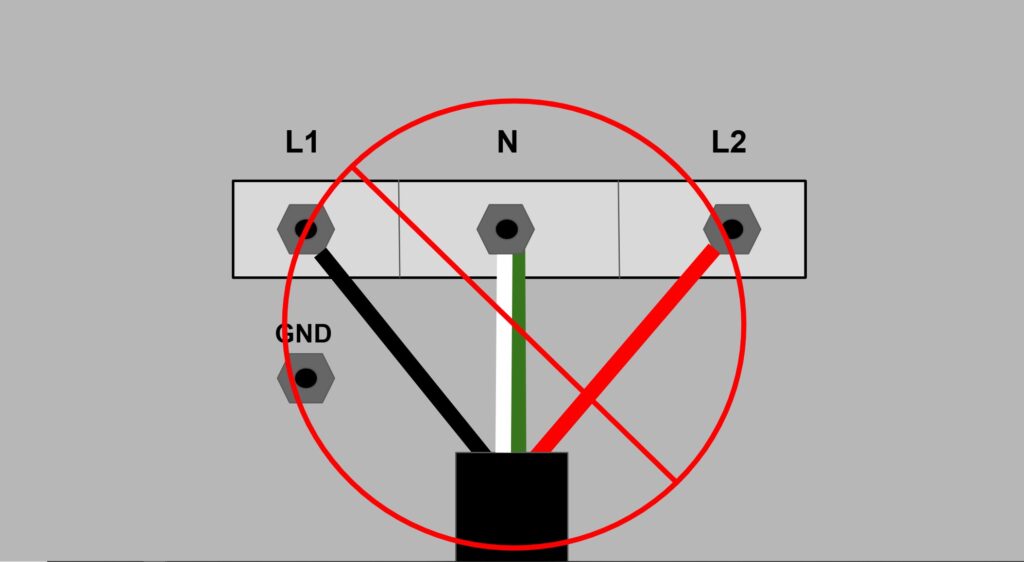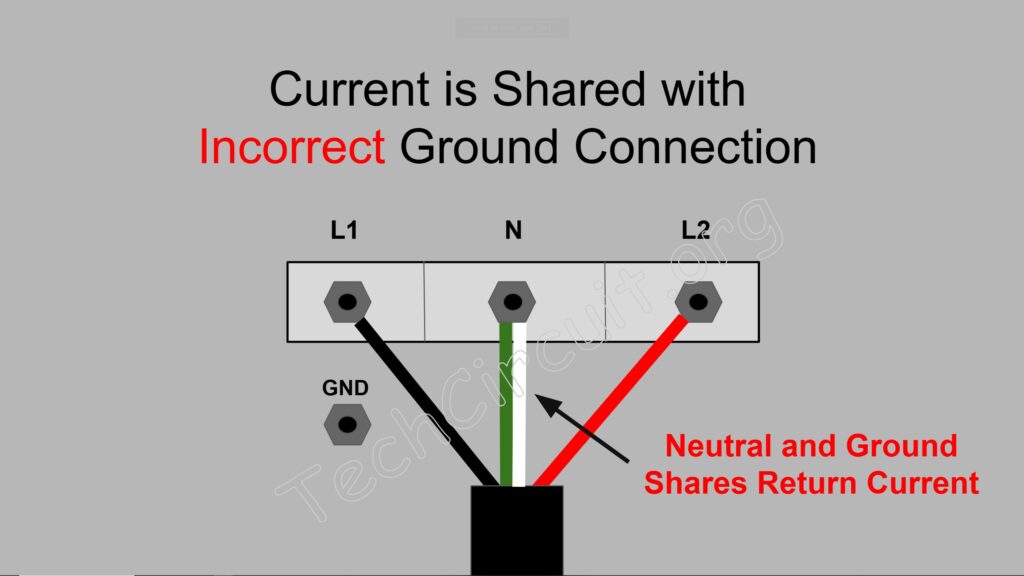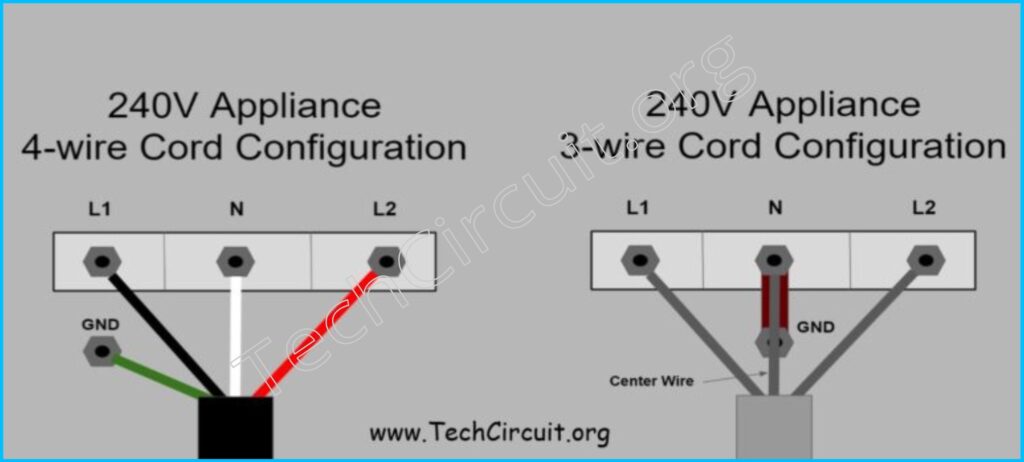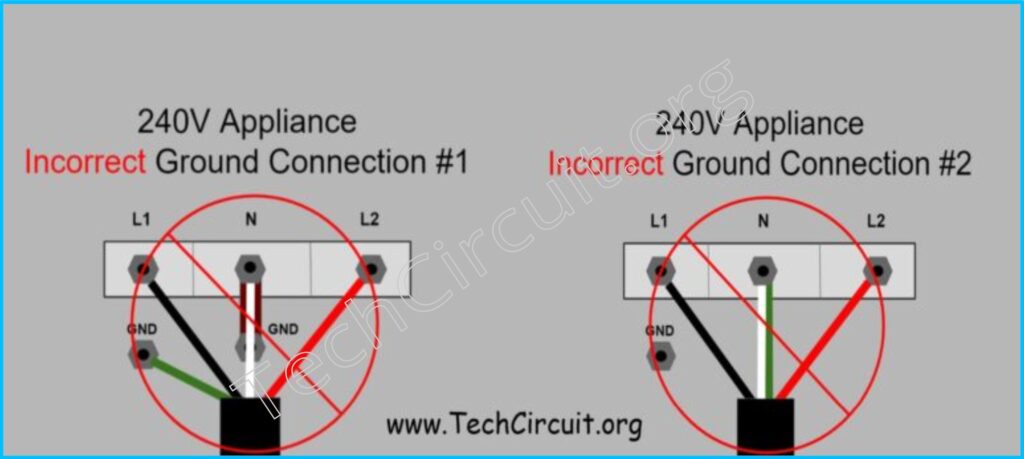
In the field, it’s not uncommon to see neutral and ground bonded together at the terminal block of a 240V appliance—especially on ranges and dryers. Sometimes it’s done out of habit, other times from misunderstanding the wiring code. But this small connection can have major implications. In this article, we’ll walk through why neutral and ground must remain separate at the appliance in modern installations.
Purpose of the Ground Connection
The ground wire exists purely for safety. It’s not meant to carry current during normal operation—it’s there to provide a safe path back to the panel if something goes wrong. If a hot wire touches a metal cabinet or frame, the ground gives that fault current a low-resistance path back to trip the breaker.
In other words, grounding is your backup plan. It’s there for when things go wrong—not to carry current under normal conditions.
Shared Current
When neutral and ground are bonded at the appliance, you’ve just routed some of the return current onto the ground wire. That’s not what it’s for.

Here’s what happens: the neutral normally wire carries unbalanced current from the appliance’s 120V loads (like timers, control boards, motors, or lights). If you tie that neutral to ground at the terminal block, then current can now return on both the neutral and the ground wire, since they’re electrically connected. This creates parallel paths, and current will naturally split between them.
Now your safety ground is no longer clean—it’s carrying return current. That can create voltage on the metal chassis of the appliance, and worse, even backfeed onto the grounding system of the home.
Correctly and Incorrectly Wired 240V Terminal Blocks
Below are examples of correctly wired and incorrectly wired terminal blocks. The first image is of both a 4-wire cord connection and a 3-wire cord connection. The 4-wire connection has a separate ground wire connected to the appliance chassis. neutral is NOT bonded to the chassis. In the case of the grandfathered 3-wire connection, neutral IS bonded to the chassis. However, there is not a separate ground wire to share current back to the breaker box. Both configurations are correct for their respective cord types.

Below are two examples of incorrectly wired 4-wire cords that effectively bond ground and neutral. In both cases, both neutral and ground share the current back to the breaker box. Terminal blocks should NOT be wired in this manner.

Safety Considerations of Bonding Neutral and Ground
Let’s say a technician bonds neutral and ground at a range. Later, someone installs a GFCI breaker upstream. The moment the appliance starts using any 120V circuit, the breaker trips. Why? Because GFCIs detect current returning on a different path than it left on—and now some of that current is leaking onto the ground.
Even worse is the case of a broken neutral somewhere upstream. If neutral and ground are bonded at the appliance, the entire neutral return is now flowing through the ground wire, possibly all the way back through conduit, green wires, and the entire bonding system of the house. That’s a fire hazard because the ground wire is often thinner than the neutral line and not rated for the continuous current it may be subject to. It is a shock hazard because if the ground connection breaks upstream, the chassis can become live. Further, there are other potential “shock” scenarios associated with incorrect bonding.
It’s also a code violation under modern NEC rules. The only place neutral and ground should be bonded is at the main service panel—nowhere else.
Potential Damage to Control Boards and Electronics
When neutral and ground are bonded together at the appliance, it opens the door to unintended current paths during a short circuit or fault condition. If a hot wire shorts to the appliance chassis, the fault current is supposed to flow cleanly through the ground wire back to the breaker panel to trip the breaker. But when neutral and ground are tied together at the appliance, some of that high fault current can travel back along the neutral wire and raise its voltage drastically above the normal zero volt potential – taking out sensitive electronic components like the control board. This can lead to voltage spikes, damaged traces, or blown components, especially in modern appliances that rely on low-voltage logic circuits. In essence, bonding neutral and ground at the wrong place your appliance’s control board at risk of an unnecessary over-voltage condition that can destroy it.
Disclaimer
The information provided in this article is for educational and informational purposes only. While every effort has been made to ensure accuracy, The Tech Circuit and its contributors are not responsible or liable for any damages, injuries, code violations, or other outcomes resulting from the use or misuse of this content.
Electrical work can be dangerous. Only qualified individuals should perform repairs, installations, or modifications involving electrical systems or appliances. Improper handling of electrical components can lead to shock, fire, equipment damage, or even death.
It is your responsibility to ensure that any work you perform complies with all applicable local laws, codes, and regulations, and to consult a licensed electrician where appropriate.
By using the information on this site, you assume full responsibility for your actions and outcomes.
Test your Knowledge
Why Neutral and Ground Should Not Be Bonded at the Appliance
Select the best answer for each question.
Summary
Neutral is for return current. Ground is for safety. They serve two different purposes and should not be joined at the appliance.
While it was allowed in older homes with 3-wire cords and no separate ground, today’s 4-wire systems keep neutral and ground isolated for a reason: to protect you, your customers, and the integrity of the home’s electrical system.
Don’t forget:
“Diverting 10 min/day of social media time towards learning something new, is 5 hours of newfound monthly knowledge.” – SM
To DONATE to the Tech Circuit – CLICK HERE
Alphabetical Links to all Tech Circuit Articles and Blogs – CLICK HERE
Links to all Tech Circuit Cheat Sheets/Field References for Appliance/HVAC Techs – CLICK HERE
For additional electrical and electronics learning material for field techs, visit the following links:
Homepage at http://www.TechCircuit.org
Facebook group at: https://www.facebook.com/groups/746823709133603
Youtube Channel: https://www.youtube.com/@TheTechCircuit
We are a participant in the Amazon Services LLC Associates Program, an affiliate advertising program designed to provide a means for us to earn fees by linking to Amazon.com and affiliated sites.
